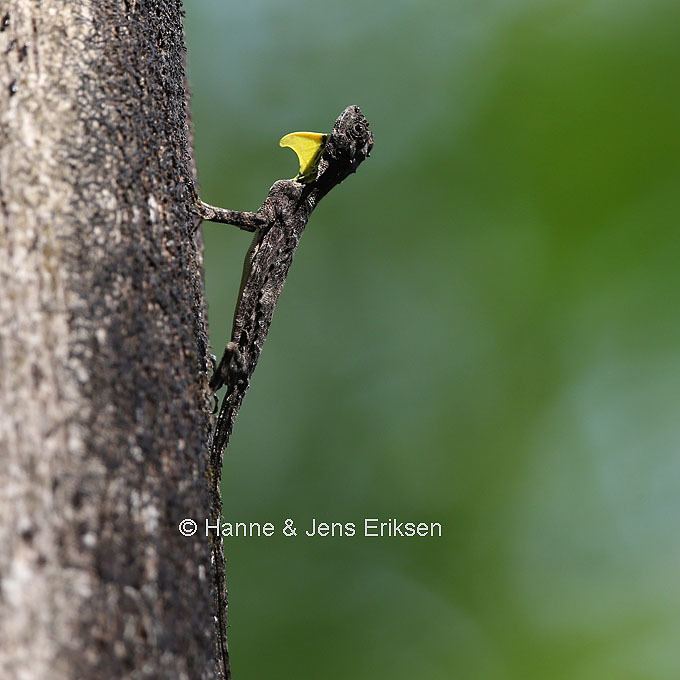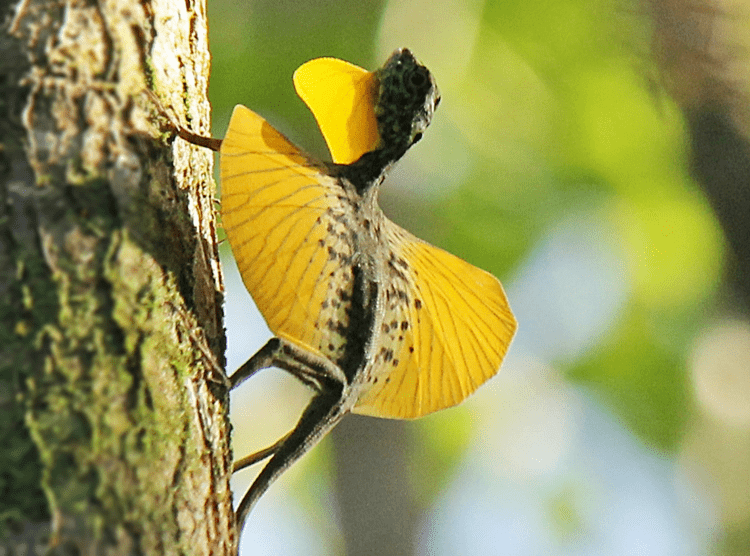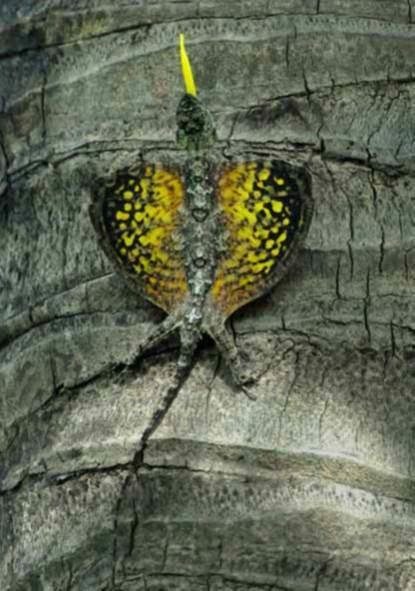Subphylum Vertebrata Scientific name Draco dussumieri | Phylum Chordata Class Reptilia Suborder Iguania Rank Species | |
Similar Draco blanfordii, Draco spilopterus, Draco mindanensis, Draco indochinensis, Draco melanopogon | ||
Draco dussumieri or southern flying lizard, is a species of agamid lizard capable of gliding from tree to tree. It is found in the Western Ghats and hill forests of southern India. They are almost completely arboreal, found on trees in forests and adjoining palm plantations where they climb tree to forage for insects and glide to adjoining trees by expanding the patagium, loose skin on the sides of the body which are supported by elongated ribs to act as wings. The skin on the sides of the neck are also extended to the sides using the hyoid bones of the tongue to support them. During the breeding season males maintain small territories which they defend from other males while courting females. Males have a more colourful patagium than females and they prominently extend their yellow dewlaps forward in display. Although living almost their entire lives on the trees, females descend to the ground to lay eggs in soil. This is the species with the western most distribution within the genus Draco, the majority of species occurring in Southeast Asia.
Contents

Description

The southern flying lizard is brown with patches of grey that match the pattern of tree bark. They can change their colour to a limited extent. They are about 23 cm long, with a snout to vent of about 7 to 9 cm and a 10 to 13 cm tail. The head is round with a short snout and the nostrils point upwards. They are active during the day after they have warmed up in the early morning sun. Males have a long yellow dewlap which is shorter in the females. These lizards climb up the trees in search of insect prey on the trunks and leap off when the reach the top to land on adjoining trees. They are able to glide by extending their patagia, flaps of skin on the side of the body that are supported by six elongated ribs with special musculature to extend them outwards. The muscles on the breast are also modified to breathe more efficiently and support their active lifestyle. In addition the sides of the neck are also stretched out to form a pair of smaller wings around the head. They are able to control the direction of the glide using their tails. The patagium is patterned on the underside with black blotches on yellow and purple. Patterns vary individually and these marking have been used to identify and estimate population sizes. A horn-like, conical tubercle behind and above the posterior part of the eye is prominent. Males have a small crest arising on the nape. The yellow gular sac on the throat is long and narrow, longer in the male. The back is rough and the throat has irregular brown spots. In addition to the patagium, the hyoid apparatus (part of the tongue) expands throat lappets horizontally so that the head is also supported on its sides by small wing like structures.
Taxonomy

The species was first described as "Dussumier's dragon" by Dumeril and Bibron who described it in 1837 in the fourth volume of their catalogue of the reptiles of the world. The specific name, dussumieri, is in honor of Jean-Jacques Dussumier, a French voyager who collected zoological specimens in India. Draco is the Greek word for dragon.

Draco dussumieri is the only species found in southern India and is the western most representative out of around 42 species in the genus Draco. This species stands out as the sole member of a lineage that represents an old branch from the common ancestor of the species within the genus. One study failed to locate the appropriate mitochondrial sequence for comparison with other species.
Distribution

This species is found principally along the Western Ghats and associated hill forests of Karnataka, Kerala, Tamil Nadu, Goa in southern India. It is also reported from some parts of Eastern Ghats (Talakona) in Andhra Pradesh Nelson Annandale recorded it as "common about ten miles north of Trivandrum, but apparently very local." It is often found in coconut and betel-nut plantations near forests.
Behaviour and ecology

The southern flying lizard feeds on insects. They are strictly diurnal and sleep at night on flat surfaces. Specimens from northern Karnataka were found to feed on a large number of ants (Oecophylla smaragdina). Males display actively from February to April in Kerala, mainly in the forenoon after the sun warms them up. Males maintain small territories and bob their head and erect the gular pouch when they spot females nearby. They also change their skin colour to become silvery grey and conspicuous before gliding towards the female. They leap off with their hind legs making use of specially adapted musculature at the base of the tail before spreading the patagium. During the heat of the day in summer they rest in the cooler canopy and become active again in the late afternoon while they bask during the cooler weather. Males chase females and court them with ritualized moves. The male mounts the female and bits the nape during copulation. Males intimidate intruding males by expanding and folding their patagium and making conspicuous movements. These lizards are almost entirely arboreal. Females descend to the ground to lay eggs in soil during the monsoons. About four eggs are laid which hatch after fifty days or so.
In a population estimate made in an areca plantation in the Western Ghats, the density was found to be about 13 per hectare. The population density was much lower, less than 2 per hectare, at Valparai which is at a higher altitude.
The southern flying lizard has many predators including arboreal snakes and birds. Two species of bird that have been observed to feed on them include the Indian golden oriole and the black-capped kingfisher. Lion-tailed macaques have been noted to feed on them as well.
In fiction
Draco dussumieri features prominently in a fictional work or novel named Carvalho (ಕರ್ವಾಲೊ) in Kannada written by Poornachandra Tejaswi. In this story, Carvalho (ಕರ್ವಾಲೊ) , a middle aged scientist searches for this flying lizard in the forests of the Western Ghats in the state of Karnataka India.
